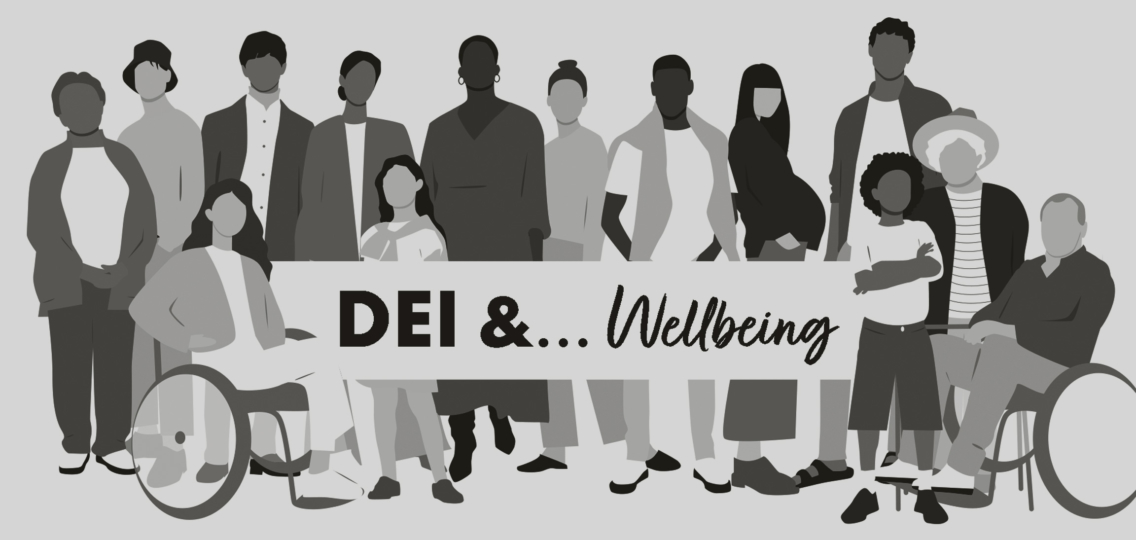What role does your wellbeing strategy play in promoting diversity, equity and inclusion in the workplace?
Over the next few months, we’re looking at how you can take positive steps to promote DEI in the workplace, from wellbeing and rewards to culture. We kick off by looking at some of the things to think about when it comes to wellbeing strategy and DEI. And next month, we’ll do the same for rewards and benefits, so be sure to tune in!
Wellbeing and DEI – building the foundations
There’s been a positive shift in recent years towards promoting diversity, equity and inclusion (DEI) in the workplace. But while it’s all very well to talk-the-talk, actions always speak louder than words. It’s the companies who show themselves to be inclusive who really shine.
The key to creating the right culture of support, unique to your organisation, relies first and foremost on understanding and knowing your workforce. And that means analysing all the data you have at your disposal to build a clear picture of your different demographics, so that you can then tailor wellbeing support accordingly. Your internal HR systems are a good place to start, but you might also consider what data you can glean from your engagement surveys, EAP provider, health insurers or pension providers. These will help you gain a true understanding of the make-up of your organisation and its diversities, and you’ll be in a better place to align your wellbeing strategy so it caters for everyone.
Know your people
Once you have a clear picture of your different demographics, it’s time to think about how you can cater for their differing needs. Wellbeing is only truly inclusive if your strategy is designed to benefit all, and that means catering for everyone’s needs. That may require adapting what you offer to colleagues based on age, ethnicity, gender, sexuality, health issues, disabilities, any caring responsibilities they may have, and so on.
According to recent research published by the Reward and Employee Benefits Association alongside AXA, age wellbeing is set for huge growth this year, with 35% of respondents to a survey saying they plan to introduce wellbeing support strategies specifically for older employees. In the same report, around half of employers say they now take a gender-targeted approach to wellbeing, and a further 34% have mental wellbeing support in place related to culture and ethnicity.
You might have the best intentions for your wellbeing strategy, but if you have a “one-size-fits-all” approach it can negate what you’re trying to achieve. You may find people feel disenchanted and not valued for who they are, resulting in low engagement levels.
To make sure you cover all your people, start by asking yourself these questions.
Can everyone access your wellbeing support?
This is something the pandemic has really put on the radar. With more of us now working remotely, smart companies are rethinking the way they support their colleagues’ wellbeing. It’s led to better recognition of employees who might never sit in front of a laptop, such as people who work in healthcare, retail or construction.
Wellbeing offerings are only inclusive if everyone can access them – and sometimes that means having a major rethink around the platforms being used, to check they’re fit for your audience. Technology is key, and it needs to be technology that’s accessible to everyone everywhere – think employee assistance app that sits on people’s mobile phones and travels with them wherever they go.
This year is also re-opening opportunities to deliver more face-to face wellbeing support – both to those who don’t sit in front of a screen all day, and those who do. Wellbeing champions, for example, are employees who are themselves passionate about workplace wellbeing, and can really help support engagement around any initiatives in place.
Is your wellbeing strategy evolving all the time?
The most important thing to remember is there’s always room for improvement. If you’re consistently monitoring progress and open to change, then you’re on the right track regardless of how diverse and inclusive your wellbeing initiative currently is.
Again, data is your friend: you can use it to track who is engaging with what’s on offer – and who isn’t. Your employee engagement surveys to get a clear picture of the overall impact of your wellbeing strategy. But don’t just rely on data to give you answers, talk to people too! With all our modern technology, sometimes the power of good old face-to-face communication is lost. If a particular employee demographic isn’t engaging with your wellbeing hub or EAP, for example, ask them why. Encourage them to put forward ideas about what they need from you.
All of these actions in themselves are a big nod toward inclusivity, because you’re including your employees in the process of change for the better.
A truly diverse and inclusive workplace doesn’t depend solely on your wellbeing offering, but a well-curated strategy has an important role to play. It can be the difference between disengaged employees and ones that feel valued, heard and supported. And of course, effective communication is the key to bringing any inclusive wellbeing strategy to life.
Could your wellbeing messaging do with a refresh to bring diversity, equality and inclusion to the fore? Come and chat to us, we’d love to help. Don’t forget to tune in next month for our DEI focus on rewards!



